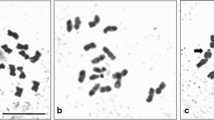Abstract
Parthenogenesis and, in particular, polyploidy are rare in animals. A number of cases, known among weevils, represent apomictic parthenogenesis—a reproductive mode in which eggs undergo one maturation division, the chromosomes divide equationally, and no reduction takes place. Among parthenogenetic weevils there are two diploids, 48 triploids, 18 tetraploids, six pentaploids, three hexaploids and one decaploid. Eight examined parthenogenetic species are triploids with 33 chromosomes of different morphology, confirming that triploidy is the most common level of ploidy in weevils. The karyotypes are heterogeneous with the presence of meta-, submeta-, subtelo- and acrocentric chromosomes. The C-banding method showed that only two species possess a large amount of heterochromatin visible as a band around the centromere during mitotic metaphase. This agrees with observations that weevils are characterized by a small amount of heterochromatin, undetectable in metaphase plates after C-banding. In three species an atypical course of apomictic oogenesis occurs with stages similar to meiosis, in which chromosomes form bivalents and multivalent clusters. This association of chromosomes probably represents the remnants of meiosis, although these events have nothing to do with recombination. The results support the hypothesis that the evolution of apomictic parthenogenesis in weevils has proceeded through a stage of automixis.










Similar content being viewed by others
References
Alonso-Zarazaga MA, Lyal CHC (1999) A world catalogue of families and genera of Curculionoidea (Insecta: Coleoptera). (Excepting Scolytidae and Platypodidae). Entomopraxis, S.C.P, Barcelona, pp 315
Block K (1969) Chromosomal variation in Agromyzidae. Hereditas 62:357–381
Korotyaev BA (1994) Use of data on distribution of the bisexual and parthenogenetic forms of weevils for faunogenetic reconstructions (Coleoptera, Curculionidae). Verhandluagen des 14. Internationalen Syposiums fur Entomofaunistik in mitteleuropa, SIEEC, pp 264–271
Lachowska D, Rożek M, Holecová M (1998) Karyotypic data on weevils (Coleoptera, Curculionidae). Folia Biol (Kraków) 46:129–136
Lachowska D, Holecová M, Rożek M (2005) C-banding karyotype and NORs analyse in eight species of Barypeithes Duval from Central Europe (Coleoptera, Curculionidae, Entiminae). Caryologia 58:274–280
Levan A, Fredga K, Sonberg A (1964) Nomenclature for centromeric position on chromosomes. Hereditas 52:201–220
Lokki J (1976a) Genetic polymorphism and evolution in parthenogenetic animals. VI. Dipoid and tripoid Polydrsus mollis. Hereditas 82:209–216
Maynard Smith J (1978) The evolution of sex. Cambridge University Press, Cambridge
Mikulska I (1949) Cytological studies upon genus Otiorrhynchus (Curculionidae, Coleoptera) in Poland. Experientia 5:473–475
Mikulska I (1950) The chromosome number in Otiorrhynchus salicic strom. (Curculionidae, Coleoptera) in Poland. Bull Acad Sc B II:269–276
Mikulska I (1953) The chromosomes of parthenogenetic and thelytokian weevil Eusomus ovulum germ. (Curculionidae, Coleoptera). Bull Int Acad Pol B II:293–307
Mikulska I (1960) New data to the cytology of the parthenogenetic weevils of the genus Otiorrhynchus germ (Curculionidae, Coleoptera) from Poland. Cytologia 25:322–333
Normark BB (1996a) Polyploidy of parthenogenetic Aramigus tessellatus (Coleoptera: Curculionidae). Colepts Bull 50:73–79
Normark BB (1996b) Phylogeny and evolution of parthenogenetic weevils of the Aramigus tessellates species complex (Coleoptera: Curculionidae: naupactini): evidence from mitochondrial DNA sequences. Evolution 50:734–745
Normark BB, Lanteri AA (1998) Incongruence between morphological and mitochondrial-DNA characters suggests hybrid origins of parthenogenetic weevil lineages (genus Aramigus). Syst Biol 47:475–494
Petryszak B (1972) Chromosome numbers of Foucartia liturata Striel., Foucartia squamulata (Herbst) and Sciaphilus asperatus (Bonsd.) (Curculionidae, Coleoptera). Zesz Nauk Uniw Jagiellońsk 18:27–63
Rożek M (1994) A new chromosome preparation technique for Coleoptera (Insecta). Chromosome Res 2:76–78
Rożek M, Lachowska D (2001) C-bands on chromosomes of four beetle species (Coleoptera: Carabidae, Silphidae, Elateridae, Scarabaeidae). Folia Biol (Kraków) 49:179–182
Rożek M, Lachowska D, Petitpierre E, Holecová M (2004) C-bands on chromosomes of 32 beetle species (Coleoptera: Elateridae, Cantharidae, Oedemeridae, Cerambycidae, Anthicidae, Chrysomelidae, Attelabidae and Curculionidae) Hereditas 140:161–170
Saura A, Lokki J, Suomalainen E (1993) Origin of polyploidy in parthenogenetic weevils. J Theor Biol 163:449–456
Seiler J (1947) Die Zytologie eines parthenogenetischen Russelkafers, Otiorrhynchus sulcatus F. Chromosoma 3:87–109
Simon JC, Delmotte F, Rispe C, Crease T (2003) Phylogenetic relationships between parthenogenes and their sexual relatives: the possible routes to parthenogenesis in animals. Biol J Linn Soc 79:151–163
Smith SG, Virkki N (1978) Animal cytogenetics, vol 3: Insecta. Part 5: Coleoptera. Borntraeger, Berlin
Stenberg P, Terhivuo J, Lokki J, Saura A (2000) Clone diversity in the polypoid weevil Otiorhynchus scaber. Hereditas 132:137–142
Suomalainen E (1940) Beiträge zur Zytologie der parthenogenetischen Insekten. I. Coleoptera. Ann Acad Sci Fenn Series A IV Biol 54:1–144
Suomalainen E (1947) Parthenogenese und Polyploidie bei Rűsselkäfern (Curculionidae). Hereditas 33:425–456
Suomalainen E (1969) Evolution in parthenogenetic Curculionidae. Evol Biol 3:261–296
Suomalainen E, Saura A (1973) Genetic polymorphism and evolution in parthenogenetic animals. I. Polyploid Curculionidae. Genetics 74:485–508
Suomalainen E, Saura A, Lokki J (1987) Cytology and evolution in parthenogenesis. CRC Press, Boca Raton, Florida
Sumner A (1972) A simple technique for demonstrating centromeric heterochromatin. Exp Cell Res 75:304–306
Takenouchi Y (1969) A further study on the chromosomes of the parthenogenetic weevil Listrodes costirostris Schőnherr from Japan. Caryologia 34:360–368
Takenouchi Y (1970) Three further study on chromosomes of Japanese weevils (Coleoptera: Curculionidae). Can J Genet Cytol 12:273–277
Takenouchi Y (1976) On the chromosomes of parthenogenetic Curculionid weevils in Japan. Proc Jpn Acad 52:126–129
Takenouchi Y (1978) A chromosome study of the parthenogenetic rice water weevil, Lissorhoptrus oryzophilus Kuschel (Coleoptera: Curculionidae) in Japan. Experientia 34:444–445
Takenouchi Y (1983) The occurrence of a decaploid embryo in the pentaploid parthenogenetic weevil race as a result of a low temperature treatment (Curculionidae: Coleoptera). La Kromosomo II(30–31):935–936
Takenouchi Y (1986) Origin of parthenogenetic weevils. Iden 40:50–89
Wanat M, Mokrzycki T (2005) A new checklist of the weevils of Poland (Coleoptera: Curculionoidea). Genus 16:69–117
Acknowledgements
This research was supported by the Polish Ministry of Science and Information Society Technologies, grant number 3PO4C 085 to Dorota Lachowska and by VEGA (Scientific Grant Agency of the Ministry of Education and the Slovak Academy of Sciences), grant number 1/3277/06 for Milada Holecová.
Author information
Authors and Affiliations
Corresponding author
Rights and permissions
About this article
Cite this article
Lachowska, D., Rożek, M. & Holecová, M. New data on the cytology of parthenogenetic weevils (Coleoptera, Curculionidae). Genetica 134, 235–242 (2008). https://doi.org/10.1007/s10709-007-9230-x
Received:
Accepted:
Published:
Issue Date:
DOI: https://doi.org/10.1007/s10709-007-9230-x




